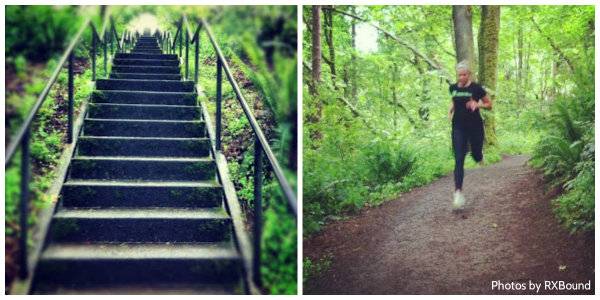The benefits of incorporating different scales, variations, and degrees to running are endless. They are also vital to run training and transfer well into just about any other sport. If running is your “thing” (or just something you love to do), then I am sure you understand how important running variations are. Changing it up a little bit with stairs and hills helps improve agility skills, speed, muscle endurance, and so much more. If you are not the biggest fan of running, then these are also great ways to mix it up and make it more interesting. In fact, you might just become a fan of running. But no matter who you are, the benefits are great – as long as you’re doing it right.
Running Stairs: On the Way Up
Speed is key, but it isn’t really all about the legs either. Be quick, but light on the feet. Land on each stair on the front three-quarters of the foot, toes slightly pointing inwards, and keeping low amortization at impact. In other words, do not slam the feet to the ground or land or drive flat-footed.
Use your arms! Arms are [the] key to running and sprinting, and are especially useful for anything uphill or anything utilizing knee movements. I cannot emphasize the use of the arms enough. The action of the arms essentially move the legs, so remember this anytime you walk, run, sprint, bounce, lunge, jump, or hop. Arms should be kept tight, bent at ninety-degree angles and close to the sides. The arms correspond with the legs – opposite arm matches with opposite leg – so work on matching the timing between both upper and lower body.
The upward climb is now a forward drive. It is a push, pushing from behind the hip and away, using glutes and hamstrings. It is not a pull from the ground, moving backward. Instead, we drive off each step, pushing the ground away and moving the body and energy forward. Remember, the arms will help you move faster and more efficiently (as you tire they can pick up where the legs often leave off). Another key here (and to all sports) is building and maintaining a tight core and a strong low back. Keep the chest up and don’t forget to breathe.
Running Stairs: Headed Back Down
There is a great tendency to fall into a “knee-dominant absorption” versus a “glute-dominant force reduction.” It is typical to see many athletes being quad-dominant. Too often sports neglect the posterior chain. Real strength and power comes from the rear, so transferring that power and energy onto the glutes, hamstrings, and low back will help just about everything along – and make it go faster.

When gravity is coupled with poor biomechanics, it will most often lead to injury. The remedy to poor biomechanics is to start at the hips. Avoid swinging the hips out to the sides as you come down the stairs. You might be doing this if you find yourself swinging your feet out and around the body. Focus instead on keeping the knees over the second toe and keeping the hips in line. If that is difficult, the side rails will help until you start to adapt to the mobility. I am not a huge fan of jogging downhill, but you can, of course. Either way (walking lightly or jogging), maintain a tight core, tight low back, and level hips.
Be intentional with each step. It is helpful to shake out the arms also. Save the energy for your incline, so if you are using the arms properly, you will definitely appreciate the recovery time to relax them a bit. (I am now assuming you used them going up!)
Uphill Running and Accelerating Uphill
I am a big fan of accelerations, and when combined with hills, they add an entirely new element to training. However, when accelerations are done improperly, they might do more harm than good. Here is the proper way to run an acceleration uphill.
Running Hills: Uphill
 First, find a lower grade that climbs to higher grade. The grade is up to you depending on what you are trying to achieve, but if an acceleration is done well, the grade doesn’t have to be great. Starting at the bottom, begin running and gradually increase your arm speed, lean more and more forward, and create more force and drive off the foot.
First, find a lower grade that climbs to higher grade. The grade is up to you depending on what you are trying to achieve, but if an acceleration is done well, the grade doesn’t have to be great. Starting at the bottom, begin running and gradually increase your arm speed, lean more and more forward, and create more force and drive off the foot.
As your speed increases, so does the weight distribution on the foot as it slowly moves its way more forward towards the toes. This doesn’t mean take to take more, or shorter, or faster steps. Instead it means to create more power pushing away from the hip, pushing through the glutes, and engaging the hamstrings to drive you forward and lengthen your stride as you accelerate.
A mistake I see often is a runner becoming more and more choppy in his or her step (usually shortening the stride to gain speed), burying the head, and dropping the arms lower towards the ground. Avoid doing all three of these. Keep the chest open, arms close to sides pumping at ninety degrees, and lengthening the stride. Again, this is a push as opposed to a pull. Most hamstring injuries occur from the pull. Drive with your engine from behind.
Running Hills: Downhill
When you’re headed downhill, don’t put on the brakes, let the body relax (without collapsing through the midline) and let the gravity of the decline take you with it. You will stay in control by keeping the core and low back tight and strong.
Watch your step but don’t be afraid to take long ones. Let the legs lengthen and relax, and let the arms relax a bit (this is good time to shake them out as you will need them again going back up). Like a rollercoaster, the speed you gather on your downhill descent will help carry you uphill, so use the speed to your advantage and regain potential energy all at the same time. Keep the chest open and eyes forward, and don’t forget to breathe here either. Be careful not to go flat-footed, but stay light on the feet and absorb the impact instead of fighting it.
Keep these training tools in mind the next time you set out to the track or trail. Just like everything else in sports and athletics (and in life), it takes repetition and practice, but the time and effort is worth it and the work will pay off. The more you practice these techniques, the more natural it will become and the results will speak for themselves.
Photos courtesy of Katie Chasey and RXBound.






